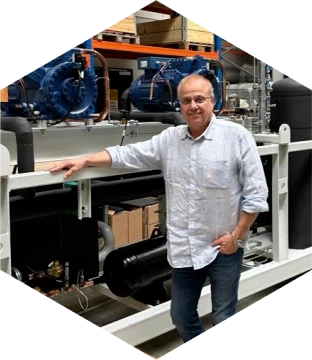Photovoltaic (PV) solar technology has emerged as a clean, cheap, reliable, and effective solution for electricity generation, making it a pivotal contributor to combat climate change. PV still has many challenges that must be met to facilitate growth; however, the answer to these challenges can come from solutions to other areas in the decarbonization process.
A significant portion of our energy consumption is devoted to heat applications – 50% of all energy end-use and 74% of energy in industry. One example is water heating, from domestic showers to industrial processes. As most of that heat comes from burning fossil fuels, and not from electricity, we must deploy efficient and clean heating solutions to decarbonize our economy fully.
This article will discuss why and how efficient heat generation solutions such as heat pumps + Thermal Energy Storage (TES) can synergize with PVs’ electricity production, enhancing its effectiveness by tackling some of its significant challenges while assisting in decarbonizing heat.

PV electricity production advantages
Beyond its vast ecological merits, PV technology offers several advantages and benefits.
One of the critical advantages of PV is its scalability. One can install PV systems on various scales, ranging from small residential rooftop installations to large-scale solar farms. This scalability allows for flexible deployment, making PV suitable for diverse energy needs and geographic locations.
Cost-effectiveness is another significant advantage. Over the years, the cost of PV technology has significantly declined, making it increasingly competitive with traditional energy sources. The falling prices of production, installation, and operation, various financial incentives, and favorable policies have made PV one of the cheapest sources of electricity.
PV electricity production challenges
Despite these advantages, PV faces some significant challenges. Intermittency is crucial, as solar energy generation depends on sunlight availability, which only sometimes coincides with power demand.
PV cannot produce electricity on demand 24/7 and has a limited capacity to facilitate essential practices such as peak shaving and load shifting. During peak demand periods, electricity grids often struggle to meet high energy generation with lower energy requirements. PV cannot directly address these challenges, as peak electricity demand can occur when solar energy production is lower and vice versa.
This challenge is usually mitigated using storage solutions such as expensive batteries and pumped hydro in the electricity area. As most players offer the same answer with no differentiating factor: PV array, batteries/EV charging, in an environment of increasing cost of financing, they need help to improve competitiveness and increase savings while reducing emissions for their customers.
The answer to these challenges may be related to heat.
Heat pumps + Thermal energy storage + Smart Control: Perfect Synergy with PV
After reviewing the challenges, it is clear that there is a need to bridge the gap between PV’s electricity generation and the heat requirements of various sectors, such as the food and hospitality industries, district heating, buildings, etc.
One optimal solution is an industrial heating system combining thermal-solar collectors, heat pumps, TES, and an advanced control system. This solution can solve some PV electricity providers’ issues while creating a synergetic partnership with the heat producer.
Heat pumps use electricity to generate heat very efficiently. Heat generation based on industrial heat pumps can, when using thermal storage (much lower cost than batteries) , use electricity in low-cost hours and store the heat for use when needed. In extreme cases, the cost of electricity can even be negative, and then using the PV electricity can serve as peak shaving, creating a Win-win situation for the PV assets and the industrial users. By capitalizing on low-price periods, the combined systems can ensure cost savings and maximize energy efficiency while providing a solution for high-price periods where electricity demand exceeds supply.
Problems become opportunities – PV developers partnering with heat solution companies.
Synergizing PV electric production with efficient heat generation and thermal storage solutions using smart control can help achieve a sustainable energy future. TIGI Solar, a leading provider of industrial heating systems, offers such a solution.
TIGI’s system comprises a new type of solar thermal collector, industrial heat pumps with TES and cloud services, and optimization control. The system optimizes energy usage, reduces costs, and can minimize reliance on non-renewable sources by harnessing solar energy directly and surplus PV electricity during production surges or low-price periods, thus transforming challenges into profit.
Furthermore, TIGI provides its solution through the HaaS (Heat as a Service) model, which works extremely well with the PV model, especially in the C&I (commercial and industrial) domain. The offered service covering renewable electricity and renewable heat with storage of both power and thermal energy covers a much wider part of the energy emission challenges of the users, leads to more significant savings, enables a larger PV field because more energy is needed for heat that was previously delivered by burning fossil fuels, reduces the average cost of storage because of the mix of storing electricity with storing heat, helps with peak shaving, and minimizes Scope 1 emissions.
Unlock the full potential of PV electric production and efficient heat generation. Contact Tigi Solar to learn more about our cutting-edge solutions.







